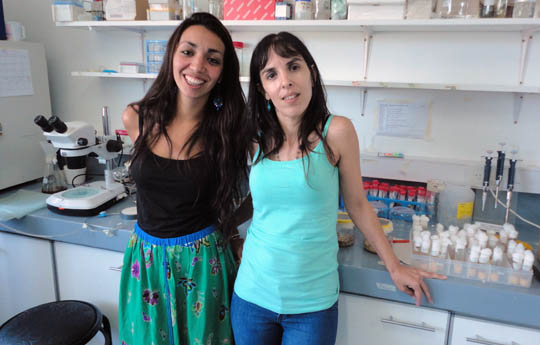BIOLOGICAL AND HEALTH SCIENCES
The key to treat cardiovascular diseases could lie in the heart of the fruit fly
Researchers at CONICET use this insect as a study model to find information about heart failures or arrhythmia in humans.
Drosophila melanogaster is the scientific name of the fruit fly. Apart from the morphological differences they have with human beings, both have similar genetic characteristics. For this reason, the insect has been usually used as a study model for human cardiovascular diseases.
A group of scientists, led by Paola Ferrero, assistant researcher of the CONICET at the Cardiovascular Research Centre (Centro de Investigaciones Cardiovasculares CIC, CONICET – UNLP), undertake a project called “Drosophila melanogaster as a study model to research into human cardiovascular diseases”.
“These flies are about four millimetres long. In spite of the differences, the heart and the genes work in the same way they do in humans”, Ferrero explains. “They are smaller and have a less complex genome than the humans but their genes are similar and produce the same proteins”, she adds.
From the beginnings of the XX century, D. melanogaster has been used as a genetic study model for other illnesses that affect humans, such as diabetes, Parkinson’s or Alzheimer’s diseases, neuronal or development disorders.
“We examine the effect of ageing in the fly and extrapolate it to observe how it impacts on the human heart. Through this study, we can analyse if a gene is increased or reduced and the effects it has on a cardiovascular genetic disease. In our country, this line of research did not exist”, the scientist states.
Besides, so far there were only two research teams in the United States that conducted experiments with these insects for the study of cardiovascular diseases. Since 2012, in collaboration with colleagues of the Autonomous University of Chiapas (Universidad Autónoma de Chiapas) in México, Argentine scientists began to work on the new line: “We shared the same interest so we made an agreement and became a reference group on this subject matter in Latin America”.
Apart from Ferrero, Manuela Santalla, PhD in Genetics and doctoral fellow of the Scientific Research Commission (Comisión de Investigaciones Científicas) of the Province of Buenos Aires (CICPBA) at the CIC; Carlos Valverde, assistant researcher of the CONICET at the CIC; Alicia Mattiazzi, senior researcher of the CONICET; and Ezequiel Lacunza, assistant researcher of the CONICET at the Faculty of Medical Sciences of the National University of La Plata (UNLP) participate in the project.
“Our study arises from the convergence of three disciplines: physiology, genetics and molecular biology”, Ferrero describes and adds: “With them, we began to work on ageing and analysed certain genes which affected the heart. We found that they impact on the fly, so now they are good candidates to be studied in humans”.
In a recent publication of the scientific magazine PLOS One, the researchers emphasized the functioning of one particular enzyme called CaMKII, which is part of the proteins that regulate the functions of the heart. Variations in its expression levels alter the cardiac function both in D. melanogaster and humans.
For Santalla, “there are proteins that so far were only known for their canonical role, that is to say, for fulfilling the task of activating during the situations in which the cell only needs to produce proteins. With this study we noticed that apart from that function, they regulate calcium and cardiovascular physiology”.
“This new function, unknown so far, allows us to state that if we modify the levels of expression of these proteins, the heart works in a different way. Also, it changes the heart rate or the inotropy, which is the force with which it contracts. This can be a significant point of pharmacological regulation: if we prove that they behave in the same way as in humans, these proteins can be therapeutic targets because we would be able to focus on their regulation, either inhibiting or activating them, in order for the body to readjust its function to a most physiological situation”, Ferrero adds.
Some of the advantages of working with D. melanogaster are the fact that the complete map of its genome is known and its short life cycle, which helps accelerate the studying processes: “If one needs to perform a chronic experiment with a mouse, the tasks may take two years. Life expectancy in the fly is about 80 days, so in the following two months we will be able to observe what happens to an entire generation. Every 15 days we have a new complete life cycle”, Ferrero describes.
“For the biochemical studies, however, we need to gather several hearts of flies. In the case of mice, for instance, it is only necessary to work with one, but with flies we have to collect 100 in order to conduct the study. Furthermore, they are one millimeter long, what forces us to develop great skills and dexterity”, Santalla concludes.
- By Marcelo Gisande. CCT La Plata.
- Sobre investigación:
- Paola Ferrero. Assistant researcher. CIC.
- Manuela Santalla. Doctoral fellow. CICPBA. CIC.
- Carlos Valverde. Assistant researcher. CIC.
- Alicia Mattiazzi. Senior researcher. CIC.
- Ezequiel Lacunza. Assistant researcher. FCM. UNLP.
- Javier Aguilar Fuentes. Researcher. Autonomous University of Chiapas, México
